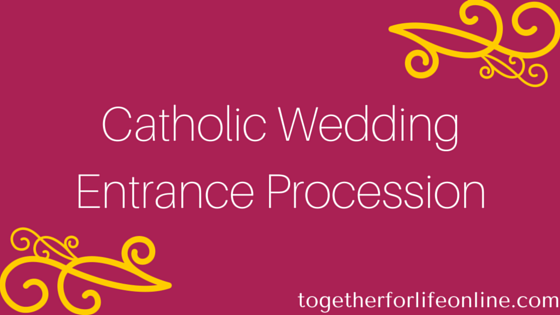
It’s hard to overestimate the amount of nervous energy surrounding the wedding entrance procession. This is probably truer for most brides than grooms simply because of the care and expense involved in choosing a wedding gown. For brides, the procession is often the grand viewing of that gown and grooms can get caught up in the anticipation as well.
The entrance procession often seems like the point of no return on the wedding day so couples naturally want it to be perfect. In a Catholic wedding, the procession is linked with all other liturgical processions and is simply a joyous, celebratory way to move people from one place to another. Processions signal beginnings, endings, or transitions from one part of a liturgy to the next.
A History of Entrance Processions
Processions are a very ancient tradition in Christianity. In contrast to a parade, which is staged for entertainment value, a procession symbolizes the journey that is the Christian life, always moving toward ever greater life.
One of the earliest images of a procession we find in the Bible is the Exodus account of the Israelites moving out of slavery in Egypt. Led by Moses, they left Egypt and walked through the Red Sea toward a new life on the other side. The women brought out tambourines and sang a song of praise to God who had set them free. Throughout the Bible, and throughout Church history, processions continue to be marked with music and singing. The Order of Celebrating Matrimony presumes that your wedding procession will also include instruments and song, ideally sung by all those assembled.
Alternatives to an Entrance Procession
The order suggests two alternatives for the opening procession of a wedding:
1. One option is to have the priest or deacon greet you at the door of the church and process before you toward the altar, similar to the start of a typical Sunday Eucharist.
2. The other option is to have the priest or deacon standing at the foot of the altar to greet you as you process toward the front of the church.
In either case, you will walk at the end of the procession, because the two of you are the primary ministers of marriage and primary ministers enter last in liturgical processions.
Choosing the Form of Your Entrance Procession
The rite calls for you to process as a couple and notes that if local custom suggests, you may be escorted by your parents and your witnesses (usually the maid of honor and best man). Such flexibility is characteristic of the wedding liturgy; it allows for a good deal of cultural adaptation.
In the United States, the groom is at times left out of the procession and the bride comes in with her father. Your parish will likely permit such an arrangement, and whoever is helping you plan your wedding will direct you to local guidelines.
When planning your procession, be careful to consider the message that the order you choose communicates. It is important to recognize that every action in liturgy is symbolic.
The custom of a father “giving away” his daughter is rooted in a time when marriage was primarily an economic transaction in western culture. Women needed the income potential of a man and men needed the domestic skills that women provided in order for both thrive, and many times, to simply survive. Marriage was in a very real sense the ritual passing of a woman from her father’s home to that of her husband. In even earlier times, women were “given” to men in arranged marriages, often as part of a larger exchange of property and wealth.
The Order of Celebrating Matrimony expresses the mutuality of the spouses in the rights, privileges, and responsibilities of marriage. The explicit inclusion of parents in the entrance procession seeks to honor with clear recognition the roles that both mothers and fathers play in the lives of their children.
What are you hoping to communicate about your vision of marriage by the way that you order your Catholic wedding entrance procession?

